BLW Teething Tweaks: What Changes Do I Make When My Baby is Teething?
- How babies do not need to have teeth in order to begin their introduction to solid foods
- Some of the side effects of teething which may cause some changes in a baby but also cause some confusion in parents
- The Food and Drug Administration (FDA) recommendations for teething babies that talk about what could and should not be used
- How meats should be handled or cooked for baby-led weaning in order to minimize a baby's choking risk
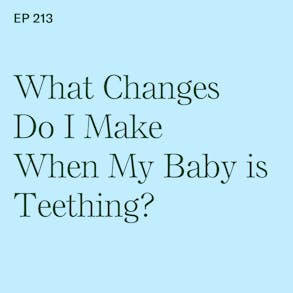
LISTEN TO THIS EPISODE
Episode Description
Do I have to wait until my baby has teeth to offer solids? Nope!..And although teething is often a time when babies begin to experience a change, it is really not necessary to make any drastic adjustments to solid foods during the teething process. In this episode I discuss the idea that having teeth is not a prerequisite for introducing solids and share some recommendations for teething babies who are ready to begin their baby-led weaning journey!
Links from This Episode
- FOLLOW Katie @babyledweanteam to learn more about baby-led weaning
- Baby-Led Weaning with Katie Ferraro program with the 100 First Foods™ Daily Meal Plan, join here: https://babyledweaning.co/program
- Baby-Led Weaning for Beginners free online workshop with 100 First Foods™ list to all attendees, register here: https://babyledweaning.co/baby-led-weaning-for-beginners
Other Episodes Related to This Topic:
- Episode 58 “What do I do if My Baby Has an Allergic Reaction? with Ron Sunog, MD”
- Episode 206 “Stay in Your Lane: Parent & Baby Roles in Infant Feeding with Marsha Dunn Klein OTR/L, MEd, FAOTA”
- Episode 177 “Red Meat Your Baby Can Safely Eat”
- Episode 178 “White Meat Your Baby Can Safely Eat”
- Episode 176 “BLW at the Butcher: Identifying Ideal Cuts of Meat for Babies with 4th Generation Butcher Cara Nicoletti”
- Episode 118 “Game Meat: How to Offer Game Meats Safely to Your Baby”
- Episode 76 “Sustainable Meat: Smart Selections for Starting Solids with Diana Rodgers, RD”
- Episode 19 “Meat: How to Prepare Meat Safely for Baby-Led Weaning”

Latest Episodes
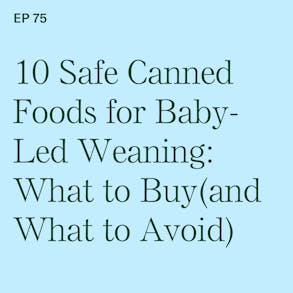

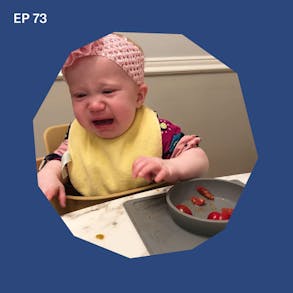
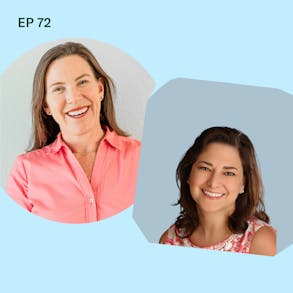
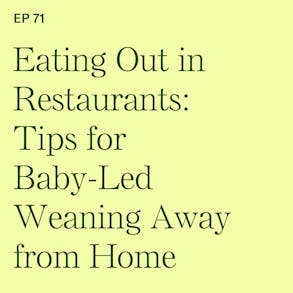
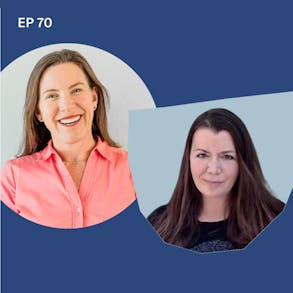
Katie Ferraro (0s):
Having teeth is not a prerequisite for needing to start solid foods. Most babies get teeth between four to seven months of age. And parents had asked me like, well, my baby doesn't have teeth yet. That means they're not ready to eat. Nope. The presence or absence of teeth has no bearing on your child's readiness to eat. Hey, there I'm Katie Ferraro, Registered Dietitian college nutrition professor and mom of seven specializing in baby-led weaning here on the baby-led weaning made easy podcast. I help you strip out all of the noise and nonsense about feeding, leaving you with the competence and knowledge you need to give your baby a safe start to solid foods using baby-led weaning.
Katie Ferraro (41s):
Well, hello. Welcome back. Today's episode is for those of you that have teething babies, baby-led weaning, teething tweaks. What Changes Do I Make When My Baby is Teething? Now I like to start out. Each of these mini baby-led weaning training episodes with a BLW tip of the day. I do two episodes a week. Monday is a mini baby-led weaning training episode. The Thursday episodes, always a little bit longer. And that's an interview with another feeding expert. So tip of the day for today, if teething is top of mind for you, I don't want to ruin the entire episode. And this is gonna be a short one, but basically you don't need to make any drastic changes to what you're doing with solid foods.
Katie Ferraro (1m 22s):
When your baby is teething, now hang tight because I'm going to be sharing some ideas on some tips and some techniques that you might employ. If you are trying to deal with teething, or you've noticed it's been a disruptor, but at the end of the day, like, do you stop solid foods? Cause your baby is teething. No, because the reality is teething is about a two-and-a-half-year process. So on average kids are going to start getting their teeth somewhere between four, seven months of age, but that's like a wide range. Okay? A or number one, babies do not need to have teeth. Having teeth is not a prerequisite for needing to start solid foods. Right? Most babies get teeth between four to seven months of age. And parents had asked me like, well, my baby doesn't have teeth yet.
Katie Ferraro (2m 2s):
That means they're not ready to eat. Nope. The presence or absence of teeth has no bearing on your child's readiness to eat. Okay. Some babies are born with teeth. It's wild. Look up pictures on Google images. Crazy. Some babies don't get teeth until after one. I have a friend. Kate is a dietitian. She has two little girls. Both of them did not have their first tooth eruption until after age one. And they did a hundred FIRST FOODS. They did baby-led, weaning. These babies could eat a hundred different foods without any teeth. Okay. I always laugh because my mom is a dietitian. She is like a totally different type of dietitian in the middle. Cause she has a business that does long-term care consulting. So she works in nursing homes generally with older people and long, long before I did infant feeding and baby Led Weaning.
Katie Ferraro (2m 44s):
I used to work with her and I remember being like, you know, you walk into the nursing home in the room and there's like tray and the dietitian I'm coming there to ask how the meal is. And like the person's dentures are in the cup next to the bed and they're eating the meal without their dentures. And I was like, oh, I guess you can eat without teeth. And then I get into baby-led weaning and I'm like, wait a minute. None of these kids don't have any teeth. Oh, I guess you can eat without teeth. So we'll talk a little bit about texture for babies who don't have teeth, but at the end of the day, you don't need any teeth to start solid foods. So it's not an excuse to hold off on starting solids. You can't wait until your baby gets teeth. Cause sometimes it doesn't even happen until after they are one, but most babies, four to seven months. And then they're going to get 20 baby teeth by the time they're three.
Katie Ferraro (3m 26s):
So this is a continuum, right? Your baby will be teething for at least around two and a half years. So can you totally stop solid foods? No, because maybes cannot live on milk alone for two and a half years. Now I want to talk a little bit about the side effects of teaming with teething comes, drool. So what happens is when babies start teething and cause for most babies, that's around four to seven months of age at six months of age, when your baby starts eating solid foods, your baby's also concurrently starting to cut teeth. And with that comes a lot of drool. And what happens with teething and drill is that baby swallows that drawer. And when babies some babies, when they swallow that drool, it leads to diarrhea.
Katie Ferraro (4m 8s):
Sorry, this is gross, but it's the reality loose stool. Let's call it. And then the parents see the loose stools and they're like, oh my gosh, it must be the foods that we're feeding. I got to stop doing solid foods cause it's giving my baby the runs. No, it's very likely the drool that your baby is walling. So just be aware that with teasing and that extra drool, you're going to see some changes in the diaper. Now, another thing you'll notice with drool is that drool drips to the side of the face and your baby's trying new foods it's happened with the baby. I was working with the other day tomatoes for the first time we were having like some tomato sauce and something else, not little cherry tomatoes. Cause we don't do that early on in baby-led weaning. Cause we have to quarter cherry or grape tomatoes and babies can't pick up those quarters before they have their pincer grasp.
Katie Ferraro (4m 51s):
So there are some other safer ways to do tomato, but it was a new food for the baby and the baby was teething and there was lots of drools. And then the tomato sauce when it hit the drill and hit the side of the face that baby got this contact rash all over the face. And the mom's like, oh my gosh, my baby's having an allergic reaction. You guys, your babies are going to have some sort of skin reaction when the new compounds from the new foods that they're trying touch their face. Now, is that a true sign of an allergic reaction skin involvement alone? No, absolutely not. I have an episode. They got to go listen to, if you don't know how to recognize an allergic reaction, go back and listen to episode 58. It's called, what do I do if my baby has an allergic reaction, it's an interview I did with Dr.
Katie Ferraro (5m 32s):
Ron Sunog, who's a pediatrician with a special interest in using food to prevent food allergies. And he's going to talk you through like what a true allergic reaction is, but be prepared that with the new foods your baby is trying plus the drool that comes with teething, you're going to get sometimes some skin rashes and some skin stuff going on on the face is at the end of the world. No, is it a sign of a true allergic reaction? Almost never, but it is helpful to be aware of what a true allergic reaction looks like. So episode 58 at BLWpodcast.com forward slash 58 can give you more information on that. So sometimes parents will say, okay, if my baby's drooling, I've seen this thing where you can put Vaseline all over the side of the baby's mouth to kind of protect it.
Katie Ferraro (6m 16s):
And yes, that's one thing you could do. You could put Vaseline on the side of your baby's not, especially for babies with very, very dry skin or lots of eczema sometimes gets recommended to be protecting the open-space. When babies are trying new foods, do you need to do that? No, not necessarily. Just be aware that with that access to eating is going to come drool. And sometimes the drool combined with the new food is going to result in some skin stuff. Just be prepared. Other times you'll hear people say, oh, my baby is teething. So I need to make all these alterations to the food. No, you really do not need to. You can continue to offer new foods when your baby is teething. You're going to have to, if you're going to get your baby, that diet diversity and a hundred different foods that we know can help your baby become an independent eater and helps reduce the risk of picky eating you're going to have to push through when they're teething.
Katie Ferraro (6m 60s):
Now I know parents will ask about, okay, what about cold foods? And yes, there are some babies who tolerate cold foods better when they are teasing. I know personally with my own seven kids, I would try to offer them like, you'd take regular yogurt and put it in little ice cubes and make like frozen yogurt, not like ice cream, frozen yogurt, but actual yogurt that you freeze. And I would give to the babies and all my kids absolutely hated it. They didn't like the cold freezer treats on their gums when they were teething. And speaking of frozen items when your baby is teething, I know when I was a baby or when I was younger, I always remember I'm the oldest of six kids that if I had opened the freezer, when I was like school age, there would always be a teaser in the freezer. And so I know some parents historically have done this where you take a teether ring or a teaser and you freeze it.
Katie Ferraro (7m 43s):
But actually the FDA recommends against freezing the Teether the rings because it can be too hard and potentially damage the baby's gum. So you don't need to freeze wet washcloths or freeze different teether toys. The two things that the FDA does recommend for helping to soothe your baby's gum is to use your clean finger to massage the baby's gum or to use a firm, but not frozen teether. Two things that the FDA recommends avoiding that we still see parents do all of the time for teething pain are the teether jewelry. So like Amber teething, necklaces, or bracelets, those are definitely recommended because of the potential, of course, for them to snap, there's been cases and reported cases of babies swallowing the jewelry and choking on it.
Katie Ferraro (8m 29s):
Or in other cases, this is so sad, but strangulation while sleeping from wearing teething necklaces or bracelets. So stay away from teething jewelry. You're also advised to avoid teething creams and teething gels or homeopathic remedies that are oftentimes sold or marketed to alleviate teething and children's gum pain. So the FDA warns against the use of any sort of topical medication to treat teething pain and children, including prescription or over the counter creams and gels or those different homeopathic teething tablets, they offer little to no benefit. And they're also associated with increased risk. So if you want to, again, review the two things to do to help alleviate teething pain.
Katie Ferraro (9m 14s):
You can gently rub or massage the gums using your clean finger or give your child a teether made a firm material, not frozen in order to chew on, okay. If it's too hard, it can hurt those child's gums. And then you always want to supervise your kids. Of course they don't choke on the teacher, but the teaser should be shaped such that they don't choke on it. People always ask me which teether I recommend. So Marsha Dunn, Klein, occupational therapist, and feeding expert feeding therapist. Who's been on the podcast. A number of times, she actually created this beautiful teether heart and her teether. I'm going to link to on the show notes page for this episode, you can find that at BLW podcast.com/ 213, she is such a loving and kind person to begin with such a wealth of knowledge.
Katie Ferraro (9m 59s):
She's always been so generous about sharing her time and her expertise here on the podcast. And she made this physical product, a teether heart, and I'll link to that. Again, BLWpodcast.com/213, and Marsha also has a 20% discount code, which I'll link to there for her own teether, their heart, which I think is such a great toy. And every baby that I've ever given it to absolutely loves it. So another tip with regard to starting solid foods and teething is that there are definitely some foods that babies do better with once they have at least one tooth. So while I'm a huge proponent of babies, being able to eat a wide variety of foods from six months of age, plus when they're showing those other reliable signs of readiness to eat, I do want to point out that some babies do do better with some foods once they have one tooth.
Katie Ferraro (10m 43s):
So I generally tend to hold on foods like corn on the cob until the baby has at least one tooth. There is nothing cuter than watching a baby corn on the cob, but it is a much more efficient experience when they have at least one tooth against which to nod the pieces of the corn off the cob. Another one that I wait on until baby has at least one tooth is chicken on the bone. So dark meat of chickens, chicken legs, wings, thighs. We loved that for baby-Led Weaning, lots of fat, lots of moistures, safer to swallow, but trying to extract chicken off the bone before you have teeth is pretty challenging. So you'll find that your baby gets less frustrated and has a lot more fun with that chicken leg. Once they have at least one tooth, we stay away from any crunchy or crispy foods for babies, especially if they don't have teeth because they can't chew them with their gums.
Katie Ferraro (11m 29s):
I don't do those foods until after baby turns one. And then when it comes to me, I'm always recommending that you only serve strips of meat, that you can easily shred between your finger and your thumb. So, as I like to say, if you can shread the meat between your finger and your thumb, then it's safe for your baby to eat with their gums. So yes, you can do meat and have lots of content on the podcast about how to make meat safe for baby-led. Weaning do lots of videos on Instagram @babyledweanteam showing you how to make meat safe for baby Led Weaning. But we don't do solid strips of meat because babies can't chew that, especially with their gums before they have teeth. So soft shreddable strips of meat are safer for baby Led Weaning. So to summarize, yes, I know your baby is cutting their teeth, but no, you don't need to make any drastic changes to your feeding schedule.
Katie Ferraro (12m 15s):
Don't pause on trying new foods. There aren't certain foods you need to avoid. There's ones you might hold on until that tooth comes through like corn on the cob and chicken on the bone, stay away from teething jewelry and any topical teething gels or ointments you can do teethers if you would like to make sure they're not frozen. And again, I'll share Marsha's teether heart on the show notes at BLW podcast.com forward slash 2 1 3. And if your kid is a little fussy during this teething process, I'm sending lots of warm wishes to you. Cause I know it can be a little troubling and a little unsettling for parents as well. But again, this is going to go on until your baby is three.
Katie Ferraro (12m 55s):
So I recommend you stick with your feeding schedule. Don't make any drastic changes. Maybe try out some of the colder foods. Some babies do do better with colder foods. I personally haven't had a lot of success with that, but you can try it out with some different textures for your baby. If they tend to prefer colder foods, there's nothing wrong with doing that for a couple of days, but don't get in the habit of feeding any one food all of the time or your baby will become conditioned to expect that food. And we don't want that. So keep up the good work, keep them that variety of trying out lots of different types of foods. If you need some ideas on the different types of foods that Babies can eat, be sure to grab my hundred FIRST FOODS list. I give away my a hundred FIRST FOODS list to everybody on my free weekly online workshop called baby LED WEANING FOR BEGINNERS.
Katie Ferraro (13m 39s):
It's all about how to get your baby to eat a hundred different foods before turning one, without you having to spoonfeed purees or buy pouches. And you can do all of these foods are most of them while your baby is teething. Sign up for this week's workshop times and grab the a hundred FIRST FOODS list at babyledweaning.co Thanks so much for listening and good luck to all the moms and dads and caregivers of those teething babies. Hang in there. This too shall pass.
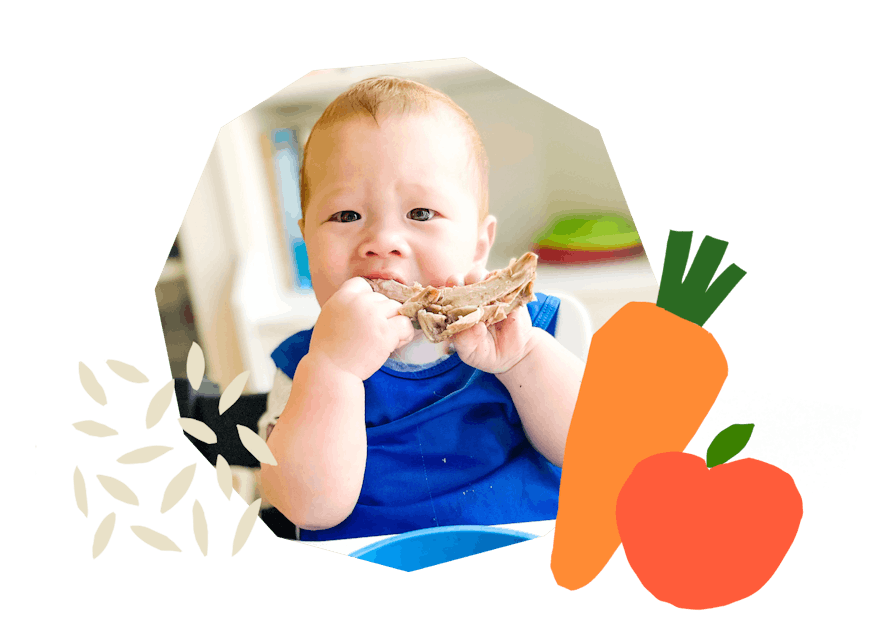
The Program Baby-Led Weaning with Katie Ferraro
A step-by-step digital program for starting solid foods safely and navigating the original 100 FIRST FOODS™ meal plan with baby-led weaning.
 EXPERT-LED, PROVEN APPROACH TO EATING REAL FOOD
EXPERT-LED, PROVEN APPROACH TO EATING REAL FOOD CONCISE VIDEO TRAININGS TO MASTER BABY-LED WEANING
CONCISE VIDEO TRAININGS TO MASTER BABY-LED WEANING 100 FIRST FOODS DAILY MEAL PLAN WITH FOOD PREP VIDEOS
100 FIRST FOODS DAILY MEAL PLAN WITH FOOD PREP VIDEOS
Baby-Led Weaning for Beginners Free Workshop
Is your baby ready to start solid foods, but you’re not sure where to start? Get ready to give your baby a solid foundation to a lifetime of loving real food…even if you’re feeling overwhelmed or confused about this next stage of infant feeding.
Get baby-led weaning recipes and tips delivered to your email inbox.

